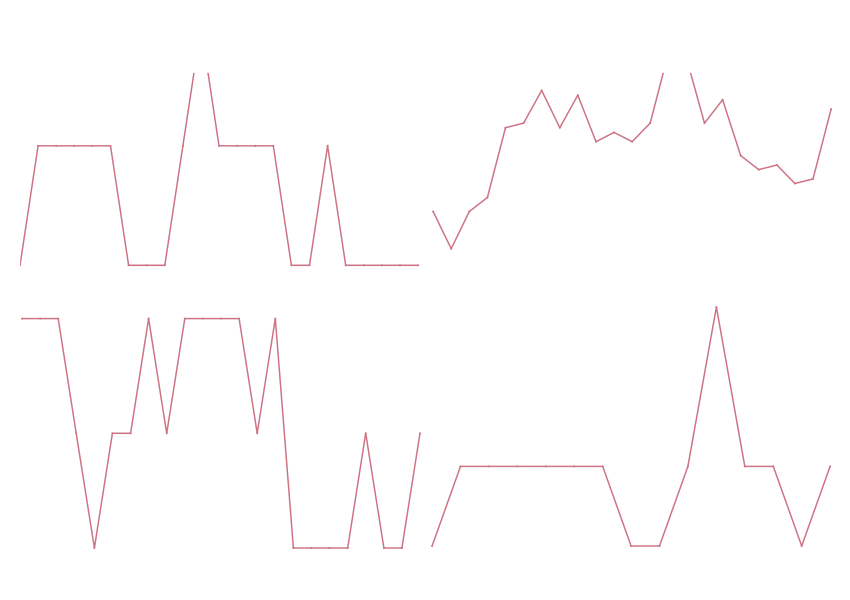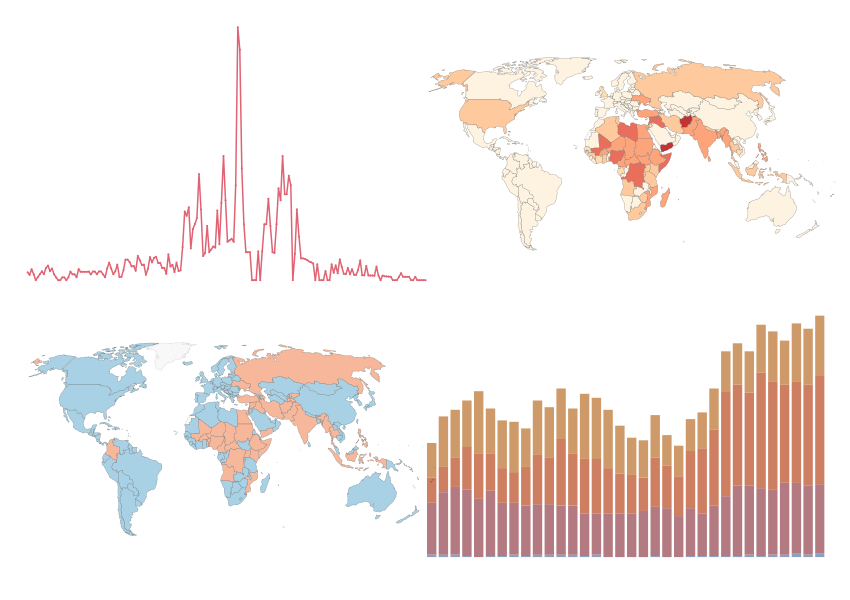How do researchers measure how common and deadly armed conflicts are?
There are several ways to measure how common and deadly armed conflicts are. What are they? And when is which measure best?
More on conflict data
Explore the metrics discussed in this article in our work on War and Peace and our Conflict Data Explorers, and read more about the data in our article on it.
Measuring how common and deadly armed conflicts are across the world helps us understand how people’s lives and livelihoods are affected by large-scale violence.
However, researchers do not only deal with the challenges of identifying armed conflicts and conflict deaths differently — they also use different measures to determine the regularity and deadliness of conflicts.
In this article, I explain which measures researchers typically use and what their respective strengths and shortcomings are.
Afterward, you can explore all these measures in the charts below, our War and Peace topic page and in our Conflict Data Explorers.
How do researchers measure how common conflicts are?
Defining conflicts
Before conflict researchers can measure how common armed conflicts are, they have to decide which conflicts they want to look at.
They could look at all types of armed conflicts. But they may only be interested in some types.
For example, if they are only interested in the risk of large wars, they could only study conflicts between participants that have organized military forces and are, therefore, most at risk of causing many deaths.
They could further restrict conflicts to those where force was not only threatened, but actually used, because this suggests that both sides were willing and able to fight.
You can learn more about how different sources define conflicts in this article.
Number of conflicts
Once researchers have decided which conflicts they want to look at, they can choose among several measures of how common they are.1
A simple measure is the number of conflicts. They are usually counted for each year, but sometimes also for other periods, such as days or decades.
The number of conflicts comes in two primary variations: the number of new conflicts, and the number of ongoing conflicts.
The number of new conflicts answers the question of how often conflicts break out. It is useful because maintaining peace is often about preventing a conflict from breaking out in the first place; parties often have more control over whether they start a conflict, and less control over how long it lasts or how much it escalates.
The number of ongoing conflicts answers the question of how many conflicts are currently taking place. It is a helpful measure considering people are affected by armed conflict regardless of whether they just started or they continue.
The charts show the number of ongoing and new armed conflicts, disaggregated by type, using data from the Uppsala Conflict Data Program (UCDP).
Conflict rate
Another measure is the conflict rate, the number of conflicts relative to the number of conflict opportunities.
For interstate conflicts, researchers estimate this number of opportunities by counting the number of country-pairs, as each country could have a conflict with every other country.2
For other types of conflicts, the opportunities are less clear, as for example the number of armed groups within a country other than the state is difficult to determine. The number of countries therefore is used as an approximation.
Dividing by the number of country-pairs or countries acknowledges that the number of countries has changed over time and that if there were more of them (such as since the mid-20th century), more of them could have a conflict between or within them.
So the conflict rate again comes in two primary variations: as the number of conflicts divided by the number of country-pairs, and divided by the number of countries.
The charts show the rate of ongoing wars by type, using data from Project Mars and Correlates of War, respectively.
Conflict participants
Another useful metric is to look at the number of countries participating in a conflict.
This measure answers the question of who is involved in conflicts. Counting the countries involved in at least one ongoing conflict has the advantage that we can more readily understand which countries and people are affected by conflict. It also considers that some conflicts affect more than one or two countries.
The map shows the participants in interstate conflicts by year, using data from the Militarized Interstate Events dataset, while the stacked bar chart shows the total number of countries participating in armed conflicts, using data from UCDP.
Conflict locations
One more approach to measuring how common conflicts are is to consider the number of countries and people where conflicts take place.
This measure focuses on where conflicts are occurring. Counting the countries and people where at least one conflict is ongoing acknowledges that a country and its people are much more affected by a conflict if it is actually fought around them, and not elsewhere.
For intrastate conflicts, the conflict participant and conflict location are the same, as the conflict by definition is fought on the country’s own territory.
The map shows the locations of armed conflicts, using data from Correlates of War and Maxim Chupilkin and Zsóka Kóczán, and the chart shows the number of states where armed conflicts are ongoing, using data from UCDP.3
How do researchers measure how deadly conflicts are?
Defining conflict deaths
Before researchers can measure how deadly conflicts are, they have to decide which conflict deaths they want to look at.
They could look at all deaths. Or they could look at specific types of deaths.
For example, they may particularly care about civilian deaths because they are not active conflict participants. Or they may be especially interested in military deaths because the combatants’ leaders may care most about their deaths when considering whether to continue fighting.
You can learn more about how different sources define conflict deaths in this article.
Conflict deaths
Once researchers have decided whose deaths they want to look at, there are several measures of how deadly they are.
The key measure is the number of deaths due to conflict. This is usually done for each year the conflict went on, or across the duration of a conflict.
The number of deaths per year emphasizes conflicts with short durations, which may be the conflicts most at risk of escalation and, thus, those researchers may most worry about.
The charts show the number of deaths in wars per year, using data from Project Mars, and the annual number of deaths in armed conflicts by country, using data from UCDP.
Death rate
Another measure is the number of deaths divided by the population, which we call death rate.
Dividing by the population tells us how likely any person was to die from conflict.
The measure is especially useful if one sees conflicts as a general cause of death and health risk.
It is also helpful for studying the evolution of conflict deaths in the longer run, as the measure recognizes that population have increased a lot, and that now many more people could die in conflicts than a century or even several decades ago.
Importantly, however, conflicts are a much more volatile cause of death than others, such as heart disease and cancer: it can be an uncommon cause of death in one year, and a leading cause of death the next, such as during the World Wars.
The map shows the annual rates of all armed conflicts by country, while the chart shows the death rates of state-based conflicts per year, both using data from UCDP.
If you now want to answer some of your questions, you can explore and compare the measures across leading data sources in our work on War and Peace and our Conflict Data Explorers.
Acknowledgements
I thank Edouard Mathieu, Hannah Ritchie, and Max Roser for reading drafts of this text and for very helpful comments and ideas.
Keep reading at Our World in Data

How do researchers measure armed conflicts and their deaths?
There are many ways to measure armed conflicts and conflict deaths. What approaches do different researchers take?

Our Data Explorers on Armed Conflict and War
Browse our two detailed data explorers on armed conflicts and war, with almost 300 interactive visualizations across six data sources.
Endnotes
The discussion of the measures draws heavily on Bear Braumoeller’s 2019 book Only the Dead: The Persistence of War in the Modern Age, whose terminology goes back to Melvin Small and David Singer’s Resort to Arms: International and Civil Wars, 1816-1980.
There are researchers who go farther, and seek to identify the number of relevant country-pairs, arguing that some countries are so far away from another, and the militaries of some so small that they are highly unlikely to engage in a conflict. See for example:
Braumoeller, Bear, and Austin Carson. 2011. Political Irrelevance, Democracy, and the Limits of Militarized Conflict. Journal of Conflict Resolution 55(2): 292–320.
Braumoeller and Carson calculate relevance scores for each country-pair based on their distance and military capabilities. We do not do this because these relevance scores are difficult to understand.
Chupilkin, Maxim, and Zsóka Kóczán. 2022. The economic consequences of war: Estimates using synthetic controls. European Bank for Reconstruction and Development Working Paper No. 271.
Cite this work
Our articles and data visualizations rely on work from many different people and organizations. When citing this article, please also cite the underlying data sources. This article can be cited as:
Bastian Herre (2023) - “How do researchers measure how common and deadly armed conflicts are?” Published online at OurWorldInData.org. Retrieved from: 'https://ourworldindata.org/conflict-measures-how-do-researchers-measure-how-common-and-deadly-armed-conflicts-are' [Online Resource]BibTeX citation
@article{owid-conflict-measures-how-do-researchers-measure-how-common-and-deadly-armed-conflicts-are,
author = {Bastian Herre},
title = {How do researchers measure how common and deadly armed conflicts are?},
journal = {Our World in Data},
year = {2023},
note = {https://ourworldindata.org/conflict-measures-how-do-researchers-measure-how-common-and-deadly-armed-conflicts-are}
}Reuse this work freely
All visualizations, data, and code produced by Our World in Data are completely open access under the Creative Commons BY license. You have the permission to use, distribute, and reproduce these in any medium, provided the source and authors are credited.
The data produced by third parties and made available by Our World in Data is subject to the license terms from the original third-party authors. We will always indicate the original source of the data in our documentation, so you should always check the license of any such third-party data before use and redistribution.
All of our charts can be embedded in any site.

